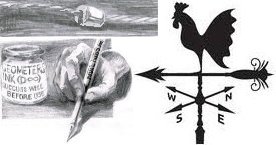That Curve!
Preamble:
On other pages, we examine
just how geometric elements may legitimately and practically be moved
in the projective domain, using elementary incidence alone.
just how geometric elements may legitimately and practically be moved
in the projective domain, using elementary incidence alone.
Here, however, we provisionally accept that peculiarly Euclidean-Newtonian-Leibnizian notion
– that elements can be moved intact, and continuously –
and, for now, leave out of consideration just how that motion might practically be brought about.
In other
words, we suppose that geometric elements can somehow be moved exactly as
physical items can (apparently) be moved — namely, intact, and continuously.
For example, we provisionally consider that a point may be slid smoothly along a line with which it is incident to any place on that line, as a bead may be slid along a wire or a string, and we consider that a line may be rotated around a point with which it is incident to any orientation, as can a weathercock round its shaft or a spoke of a wheel round its hub.

We also provisionally allow that an element can have a locus, so called, which is to say, we allow that an element can somehow leave a trace on another element, like a pen-nib leaves ink, or a palette-knife spreads paint.
(It is hard to envisage what trace a plane may leave, and on what.)
In this, as before, we again
consider that geometric elements can have the properties and behaviour
of
physical items, so that, for example, a point is thought actually to be furnished with the
practical capacity to
draw a curve on a plane, as a pen draws a curve on a sheet of paper.
Now, for Projective Geometry, the above conceptualisation is nonsense, but it will give us provisional license to explore states that projective geometry does not automatically, and may never, attain. Indeed, we will be dealing with features that very possibly cannot exist in the projective domain. However, we shall need some of them to exist in the projective domain if we are to manage imaginary elements - as we shall presently see.
We thereby see, in accordance with our suspicion that the black line is tangent to some curve, that the red and blue lines, with the two lines MH and NG and the line MN (which comes to five lines in all), must be such tangents, if the curve exists.
Note - point Z, being the incidence of
two lines, can exist only if the red and blue lines, r and b, are
coplanar, or if the lines are "shadows" of skews on a plane incident with the
green line, q.
We should therefore be able (via our temporary concessions to Euclid et al) to specify and draw the envelope of that curve, as tangents, completely, just by setting down any five lines on a plane, and using some of their intersections, as below.
We state without proof that the curve is a conic. Try dragging the black lines around to see the variations. Drag point Q on line q to observe a general tangent to the curve in action.
[By rights, the moving tangent ought to “shade” the entire plane, like
a palette-knife would, except ‘inside’ the
curve. Here, we have cheated, because the red curve shown is in fact the trace the of
its point-of-contact.]
We next use the Principle of Duality, by which, if a form is presented
as lines and points, that same form may instead, or just as well, be presented as points
and lines, and vice versa.
Specifically, duals of 'fixed' elements remain 'fixed', duals of 'mobile' elements remain 'mobile', and points that translate in a line dualise to lines that rotate in a point, and vice versa.
Specifically, duals of 'fixed' elements remain 'fixed', duals of 'mobile' elements remain 'mobile', and points that translate in a line dualise to lines that rotate in a point, and vice versa.
- Five, fixed, black lines, tangent to the curve, dualise to five, fixed, black points in the curve, G, Z, H, R & B.
- The mobile, green point, Q, translating in the fixed, green line, q, dualises to a mobile green line, q, rotating in a fixed, green point, Q.
- The fixed points, M & N, dualise to fixed lines, m & n.
- The mobile lines, m & n, dualise to mobile points, M & N.
- The mobile points, R & B, defining tangent p, dualise to mobile lines, r & b.
- Mobile line p, moving tangent to the curve, dualises to mobile point P, moving in the curve – which curve is seen as P's so-called 'locus', or 'trace'.
With this, we are brought very close to
imaginary elements .
We can work with them
when we can properly compare, projectively,
interlinear intervals .
imaginary elements .
We can work with them
when we can properly compare, projectively,
interlinear intervals .